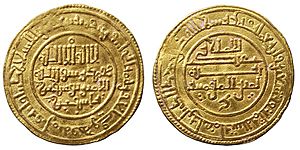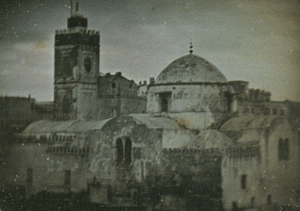Yusuf ibn Tashfin facts for kids
Quick facts for kids Yusuf ibn Tashfin |
|||||
|---|---|---|---|---|---|
| Amir Al-Muslimin | |||||

Gold dinar issued under Yusuf ibn Tashfin
|
|||||
| Reign | 1061–1106 | ||||
| Successor | Ali ibn Yusuf | ||||
| Born | Unknown | ||||
| Died | 1106 Marrakesh |
||||
| Spouse | Zaynab an-Nafzawiyyah | ||||
|
|||||
| Dynasty | Almoravid | ||||
| Father | Tashfin ibn Ibrahim Talagagin | ||||
| Religion | Islam | ||||
Yusuf ibn Tashfin (reigned around 1061–1106) was a powerful leader of the Berber Almoravid empire. He helped create the famous city of Marrakesh. He also led Muslim armies to victory in the important Battle of Sagrajas.
Yusuf ibn Tashfin came to al-Andalus (parts of Spain and Portugal ruled by Muslims) from Africa. He helped the Muslims fight against King Alfonso VI. Yusuf won the battle and helped bring Islamic rule to the area. He was married to Zaynab an-Nafzawiyyah, who he trusted with political matters.
Contents
How Yusuf Became Leader
Yusuf ibn Tashfin was a Berber from a group called the Lamtuna. This group was part of the larger Sanhaja people.
A strong leader named Abu Bakr ibn Umar was the chief commander of the Almoravids. He was a relative of Yusuf. Abu Bakr had to go deal with problems in the Sahara desert. He decided to leave Yusuf in charge of his northern lands.
Abu Bakr trusted Yusuf so much that he even gave Yusuf his wife, Zaynab an-Nafzawiyyat. She was known as the richest woman in the city of Aghmāt. This showed how much Abu Bakr respected Yusuf. It also showed how powerful Yusuf had become as a military leader. When Abu Bakr saw Yusuf's new power, he decided to stay in the Sahara. He let Yusuf keep his leadership role.
Why Muslim Rulers Asked for Help
In 1091, the Muslim ruler of Seville, al-Mu'tamid, was in trouble. His kingdom was being threatened by the strong Christian king, Alfonso VI. This was happening after the fall of the Umayyad Caliphate.
King Alfonso VI had captured Toledo in 1085. He also forced Muslim rulers to pay him money. This money helped the Christian kingdom grow stronger. It also hurt the Muslim kingdoms.
Because of this, al-Mu'tamid decided to ask Yusuf ibn Tashfin for help. His son, Rashid, told him not to. But al-Mu'tamid famously said:
I would rather be a camel-driver in Africa than a swineherd in Castile.
This meant he would rather be a humble person in a Muslim land than a rich person under Christian rule.
Yusuf's Military Victories

Yusuf was a very good general and planner. He built a strong army. This army included soldiers from Sudan, Christian fighters, and Saharan tribes. With this army, he expanded his empire.
He crossed the Atlas Mountains and captured many cities. These included Fez in 1075, Tangier in 1079, and Ceuta in 1083. He also took Algiers, Ténès, and Oran in 1082-83.
Yusuf is also known for helping to build the famous city of Marrakesh. Abu Bakr started the work in 1070. Yusuf finished it and made Marrakesh the capital of his empire.
By 1087, Yusuf had crossed into al-Andalus. He won a big victory at the Battle of Sagrajas. He came with 15,000 soldiers. They carried javelins and daggers. Most soldiers had two swords, shields, and leather armor. They also had drummers to scare the enemy. Yusuf's army had 6,000 horsemen from Senegal on white Arabian horses. They also used Camels.
On October 23, 1086, the Almoravid army, with 10,000 local Muslim fighters, stopped the Christian advance. They defeated the largest Christian army seen at that time. However, Yusuf's son died, so he quickly returned to Africa.
When Yusuf came back to al-Andalus in 1090, he saw that the local Muslim kings were not following Islamic law. He decided to take control of all Muslim lands there. He did this to spread fairness and stop unfair taxes. The kings in cities like Seville and Granada were living very fancy lives. They paid tribute to the Christians and gave Jews too much power. They also taxed their people heavily.
Yusuf believed it was time to bring back strict Islamic rules. He sent the kings of Granada and Málaga away. A year later, the king of Seville, al-Mutamid, also faced the same fate. Yusuf united almost all Muslim lands in the Iberian Peninsula with his Kingdom of Morocco. He made Marrakesh his royal court. He called himself Amir al-muslimin (Prince of the Muslims). This showed he was serving the caliph in Baghdad. But in reality, he was the caliph of the western Islamic empire. The Almoravid army was very strong at this time.
The Almoravid army had many horsemen, totaling at least 20,000. They were placed in major cities like Seville and Granada. This made it hard for the local kings to fight back. Soldiers on foot used bows and arrows, sabres, and pikes. They were protected by leather armor and shields. Yusuf also built naval bases in Cadiz and Almeria.
The Siege of Valencia
Yusuf's army did not gain much land from the Christians at first. But he did succeed in capturing Valencia. Valencia was a city divided between Muslims and Christians. It was ruled by a weak king who paid tribute to Christians, including the famous El Cid.
Valencia was a tough challenge for the Almoravid army. Yusuf sent several generals, but they could not defeat El Cid. In 1097, Yusuf went to al-Andalus himself for the fourth time. He wanted to fight King Alfonso VI. He marched towards Toledo to draw the Christian armies away from Valencia. On August 15, 1097, the Almoravids defeated Alfonso's forces again. El Cid's son was killed in this battle.
Yusuf's son, Muhammad ibn 'A'isha, who was governor of Murcia, also fought El Cid's forces. He did not capture Valencia, but he had good results. Yusuf then returned to Marrakesh.
Two years later, Yusuf came back to al-Andalus to take the eastern provinces. El Cid died in 1099. His wife, Jimena, ruled Valencia until another Almoravid army arrived in 1100. After a seven-month siege, Alfonso and Jimena gave up. They set fire to the great mosque and left the city. Yusuf had finally conquered Valencia. This gave him control over eastern al-Andalus. Yusuf is even mentioned in the oldest Spanish epic poem, El Cantar del Mio Cid.
Yusuf's Character
People described Yusuf as a "wise and shrewd man." He was not too quick to make decisions, but he acted fast once he decided. He was used to the rough desert life and did not care for the fancy ways of the Andalusian courts.
Writers from that time said Yusuf was of average height. He had a clear brown skin color and a thin beard. His voice was soft, and he spoke well. He had black eyes, a hooked nose, and curly hair. His eyebrows met above his nose.
Yusuf's Legacy
Yusuf's son, Ali ibn Yusuf, became leader after him. Ali was seen as a very religious Muslim, just like his father.
After Yusuf's death, Christians in the north gained strength. A new group called the Almohads also rose in the south around 1120. This led to the Almoravid empire slowly breaking apart. The last Almoravid rulers were Ibrahim ibn Tashfin (1146) and Ishaq ibn Ali (1146–1147).
Even though Yusuf was a respected Muslim ruler, he did not speak Arabic very well. His son, Ali ibn Yusuf, continued his father's work. In 1135, Ali helped expand the University of Al-Karaouine mosque. He made it much larger, covering over 3,000 square meters. Some stories say he hired two architects from al-Andalus for this work.
Images for kids
-
Grand mosque, Algiers in 1840 - The mosque was established by Yusuf ibn Tashfin in the 11th century
See also
 In Spanish: Yúsuf ibn Tašufín para niños
In Spanish: Yúsuf ibn Tašufín para niños



